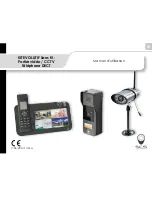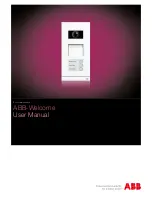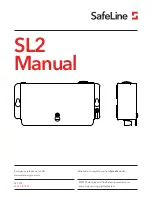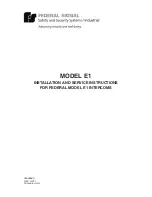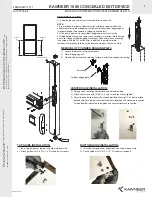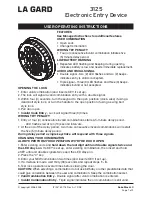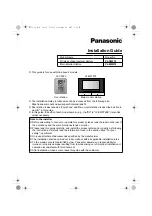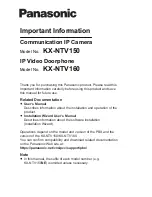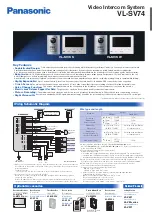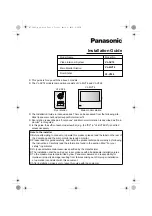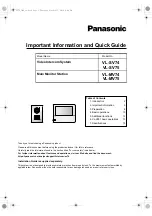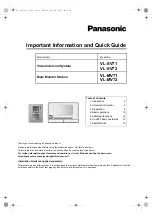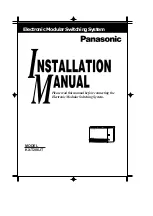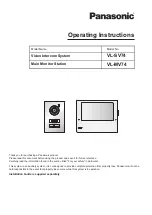
3
•
Intercom
Internal unit calls management center:
At standby status, input management center “management center key” or press “management center key” directly for main management center.
Internal unit calls other internal units:
At standby status, input internal units long press “monitor key”;
Long press “monitor key” directly for same internal unit number.
•
Function setting
1.
Setup and operation
1.1 Anti-bother setup: at standby status, adjust sound control knob, when communication LED turns red, internal unit enter anti-bother mode.
Internal unit has not ring when call is coming: at standby status, adjust sound control knob, when communication LED turns green, it enters normal mode. Internal unit will
ring when call is coming in this mode.
Note:
standby means Internal unit is not in communication with other device.
1.2. Parameter Setup
1.2.1 Enter main setup menu: at standby status, input password, then press
“#”
key. If password is wrong, 3 short tones will be heard. If password is right, there is a long tone
and internal unit enters main setup status. The default password is 2000.
1.2.2 Quit setup status: at submenu setup status, press
“*”
key to return main menu setup status. At main menu setup status press
“*”
key to quit main menu setup status,
return to standby status. At any setup status, if internal unit has not any new operation on number keyboard within 10s, internal unit will exit setup status after 3 short
tones and back to standby status.
1.2.3 Changing password: after enter setup main menu, input
“99#”
, a long tone is heard, this means internal unit is at changing password submenu status. Then Input new
4-bit password, press
“#”
key, then input new 4-bit password again, and confirmed by pressing
“#”
. If the two password input are same, one long tone is heard , this
means changing password is success full. If the two passwords input are not same, 3 short tones are heard, this means changing password is failure. During changing
password, can press
“*”
to return setup main menu.
1.2.4 Setup ring tones for calls from system: after internal unit enter setup main menu, then input
91#
to enter submenu of ring tone setup for calls from system, meanwhile,
internal unit plays current setup ring tone. Input ring tone number
“XX”
,
(XX range is: 1-12), and to confirm the setup by pressing
“#”.
If setup parameter is correct,
internal unit will play new ring tone. If not, 3 short tones will be heard and internal unit still play primary ring tone. During setup, press “*” to return to setup main menu.
The default ring tone is No. 1.
1.2.5 Setup ring tone for calls from small entrance panel: enter setup main menu, then input
92#
to enter submenu of ring tone setup for calls from small entrance panel. Setup
method is the same as
“setup ringtone for calls from system”
. The default ring tone is No. 2.
1.2.6 Setup ring tones for indoor calls: enter setup main menu, then input
93#
to enter submenu of ring tone setup for calls from other indoor units. Setup method is the same
as
“setup ring tone for calls from system”
. The default ring tone is No. 3.
1.3 Return to default password: if we forget the password, we can hold
“#”
key, then release it only after one long tone is heard. Default password 2000 is set. If there is an alarm
message that hasn’t send, internal unit will send the alarm message to management center.
2.
Alarm function and operation: SOS alarm anti-removal alarm and 8-defence area Alarm.
2.1. SOS alarm function: after external SOS alarm switch or pushbutton changes to alarm state (or press
“SOS key”
), internal unit will send SOS alarm message to management
center.
2.2. Anti-removal alarm: when internal units thief alarm defence area are enabled, if internal unit be dismantled, internal unit will send anti-removal alarm message to
management center. If anti-removal switch connected to alarm sensor, when alarm sensor is dismantled, internal unit will also send anti-removal alarm message to
management center .
Note:
don’t dismantle internal unit and alarm sensor if you have used the alarm function. Thief alarm defence areas are defence area 1, defence area 2, defence 5, defence 6,
defence 7, defence 8; fire alarm defence areas defence 3 and defence 4.
2.3. Enable or disable defence area:
2.3.1 Enable defence area
2.3.1.1 Enable by the shortcut key: at standby status, input correct password, press
“#”
key, after heard one long tone, internal unit enters setup main menu; if there is not
any enabled defence area, press
“shortcut key”
to enable all defence areas connected to alarm sensor. A long tone will be heard if enabling all defence areas is
successful. Otherwise, 3 short tones will be heard. At the same time, the enabled defence aera LEDs will be on.
Example: internal unit can connect 8 defence areas, but in fact, just 1, 2, 3, 6 defence areas have connected the alarm sensor then just defence areas 1, 2, 3, 6 could
be set by shortcut key. If defence areas 1, 2, 3, 6 are all enabled, a long tone will be heard, if just defence areas 1, 3, 6 are enabled, but defence area 2 is disabled, 3
short tones will be heard. Meanwhile, only defence area 1, 3, 6 LEDs will be on, the defence area LED 2 will be off. The reason why fail to enable the defence area is
the cause that alarm sensor is at alarm status. For defence area 2, please close door or window, then try to enable to set the defence area 2.
2.3.1.2 Enable defence area 1 by the number keyboard: at standby status, input correct password, then press
“#”
key; a long tone heard, enter setup main menu. Then,
press
“1#”
to enter submenu for operating defence area1 . Push
“1”
to enable defence area. If the operation is successful, a long tone will be heard, and defence
area LED1 will be on. If can not enable the defence area, 3 short tone will be heard.
2.3.1.3 Enable defence area 2 by the number keyboard: at standby status, input correct password, then press
“#”
key, a long tone heard, enter setup main menu. Then,
press
“2#”
to enter submenu for operating defence area 2. Push
“1”
to enable defence area. If the operation is successful, a long tone will be heard, and defence
area LED2 will be on. If can not enable the defence area, 3 short tone will be heard.
Note:
- defence area 3 to 8 can be done in the similar operation.
- The reason that can not enable the defence area: alarm sensor is at alarm status, the defence can not be enabled. Such as: when internal unit checks door
magnetic alarm sensor is at alarm status, maybe means the door or window is not closed well. So please make sure to close door or window well, then try
to enable the defence area again.
2.3.2 Disable defence area
2.3.2.1 Disable by the shortcut key: at standby status, input correct password, press key
“#”;
one long tone heard, enter setup main menu; if there is any enabled defence
area, press
“shortcut key”
to disable all thief alarm defence areas. A long tone will be heard after operation is ended, the disabled defence area LEDs will be off.
Note:
Can not disable the defence area 3 and defence area 4 (fire alarm areas) by the shortcut key.
2.3.2.2 Disable defence area 1 by the number keyboard: at standby status, input correct password, then press
“#”
key a long tone heard, enter setup main menu. Then,
press
“1#”
to enter submenu for operating defence area 1. Push
“0”
to disable defence area, a long tone will be heard and defence area LED1 will be OFF.
2.3.2.3 Disable defence area 2 by the number keyboard: at standby status, input correct password, then press
“#”
key a long tone heard, enter setup main menu. Then,
press
“2#”
to enter submenu for operating defence area 2. Push
“0”
to disable defence area, a long tone will be heard and defence area LED2 will be OFF.
Note:
defence area 3 to 8 can be done in the similar operation.
2.3.3 Exit the enabling or disabling defence area operation: at submenu setup state, press
“*”
key to quit from submenu setup and return to main menu. Then at main menu
setup status, press
“*”
key to exit main menu setup status. If internal unit has not any new operation on number keyboard within 10s, the internal unit will exit setup
status after 3 short tone.
Note:
we suggest users to disable or enable defence area by the
“shortcut key”
.
2.4. Alarm Sensor enter to the active status: after internal unit exit from setup status, the enabled defence area LEDs will be flash slowly. When the delay time is finished (for fire
alarm defence is only 2 seconds, but for the thief alarm defence area, the default delay time is 100 seconds), the alarm sensor will enter to active status. Before alarm sensor
are actived, internal unit won’t detect alarm sensor status.
2.5. Give alarm indication: after alarm sensors are active, if alarm sensor enter alarm status, the related alarm LED will flash quickly. Meanwhile, if it is fire alarm defence area, we
can heard the alarm sound, for other defence areas will not heard alarm sound if use the default setup value.
2.6. Internal unit sends alarm message to management center. After alarm sensor give alarm indication, if the related defence area is not disabled, then when the delay time is
finished (for all defence area , the default delay time is 40 seconds), internal unit will send the alarm message to management center.







